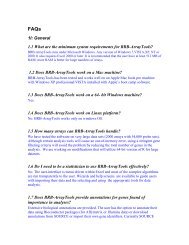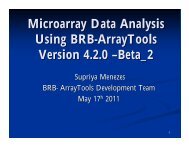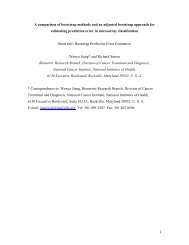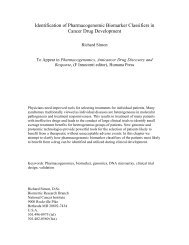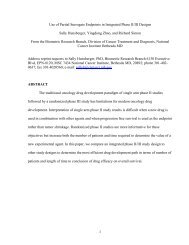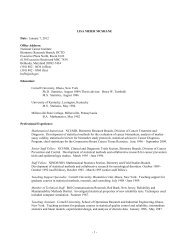Accelerated titration designs - Biometric Research Branch
Accelerated titration designs - Biometric Research Branch
Accelerated titration designs - Biometric Research Branch
You also want an ePaper? Increase the reach of your titles
YUMPU automatically turns print PDFs into web optimized ePapers that Google loves.
-<br />
ACCELERATED TITRATION DESIGNS 107<br />
the accelerated phase. As summarzed in Table 4.4, the accelerated <strong>titration</strong> <strong>designs</strong>,<br />
as used in these studies, rarely resulted in dose escalation beyond the recommended<br />
phase II dose. Only 4 of 36 exceeded the recommended phase II dose during the<br />
accelerated <strong>titration</strong> phase and only 1 death from toxicity occurred during the accelerated<br />
<strong>titration</strong> phase, among the 91 I patients enrolled in these studies. (It should be<br />
noted, however, that the use of acceleration may have contrbuted, in some trials, to<br />
exceeding the RP2D by a greater number of doses, or for a greater number of patients,<br />
than would otherwise have happened. Thus, the use of acceleration in these trials may<br />
have increased the overall number of patients treated above the RP2D, even beyond<br />
the acceleration phase itself, and thus contrbuted to a greater death rate from toxicity.)<br />
Based on its utilization in these selected studies, the accelerated <strong>titration</strong> design<br />
appears to provide an enhanced effciency with acceptable safety. However, there<br />
are a number of issues investigators might consider prior to selecting an accelerated<br />
<strong>titration</strong> design to evaluate a novel agent in a first-in-man phase I clinical tral.<br />
The use of minimum one-patient cohorts and larger dose-escalation steps may be<br />
advantageous under the following circumstances: (a) the agent is of a chemical class<br />
that has been widely studied; (b) tle agent is predicted to have minimal interpatient<br />
varability in pharacokinetics; (c) the agent's anticipated toxicity is unlikely to be<br />
severe or ireversible and is amenable to close monitoring and supportive interventions.<br />
Examples of agents most amenable to evaluation using a phase I accelerated<br />
<strong>titration</strong> design might be the following: a new formulation of a previously studied<br />
agent (e.g.liposomal formulation ofpaclitaxel), a biological agent with minimal toxicity<br />
based on animal models (e.g. antibody or small molecule inhibitor of a receptor<br />
tyrosine kinase inhbitor) or an agent for which significant interspecies varabilty in<br />
preclinical toxicology has led to a very conservative staring dose in a human phase I<br />
study. Under these circu:Qstances, the increased effciency and presumed safety of an<br />
accelerated design might make it preferable.<br />
Conversely, there are situations where an accelerated <strong>titration</strong> design may not<br />
provide the optimal balance between safety and effciency as either larger numbers<br />
of patients/dose cohort and/or smaller dose increments would be preferable. Agents<br />
associated with steep dose-response curves for toxicity, severe ireversible toxicity,<br />
unexplained mortalty in anmal toxicology studies or large varabilty in doses or<br />
plasma drg levels eliciting effects may require alternative <strong>designs</strong> to balance safety<br />
and effciency optimally. For example, larger patient numbers/dose cohorts may be<br />
preferred if there is anticipated wide interpatient varabilty in toxic effects due to<br />
pharacokinetic or pharacogenomic differences between patients. For this circumstance,<br />
larger patient numbers per dose level is appropriate since decisions about the<br />
safety of a given dose may require more than a single patient's experience. Similarly,<br />
when a pharacokinetic or a pharacodynamc endpoint, rather than toxicity, is the<br />
primar endpoint, larger numbers of patients per dose level are recommended due to<br />
anticipated interpatient varability in these endpoints. With either situation, the use<br />
of an accelerated <strong>titration</strong> design with single-patient cohorts may not be optimal.<br />
There are also situations where small dose-escalation increments may be advisable.<br />
For example, if the agent is predicted to have severe, ireversible or potentially



